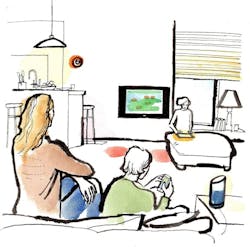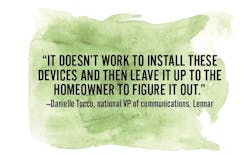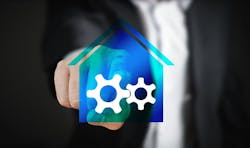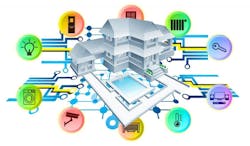2018 Housing Giants: 6 Steps for Building Smart, Connected Homes
When you realize it, you’ll have an aha moment to beat all others, like when you discover an everyday use for algebra or hear yourself quoting your parents.
It will most likely hit you when you’re tapping or swiping or speaking into your handheld supercomputer, asking it for directions, booking a flight, ordering a pizza, or checking your bank balance. This is how we live today—except in our homes. That’s the moment you’ll be ready to get onboard instead of feeling like the smart-home train has left the station with you still on the platform, or worse, stuck in the parking lot.
If you’re wondering if it’s worth the effort, consider that building “smart” or connected homes is an opportunity to crush existing home competition and meet buyer expectation with confidence while protecting yourself from risk. It’s a chance to lead instead of follow.
STEP 1: FORGET THE HYPE
Your first step is to shed the confusing and often conflicting propaganda you’ve heard from those who want a piece of the connected-home pie—mainly device manufacturers, retailers, and integrators. Those folks deserve a place at the table, but not to spin yarns about massive consumer demand for so-called “smart” things for the home that, to date, relatively few people actually have or seem to really want.
To wit, according to a 2016 smart home trends study by Houzz, a learning thermostat (think Nest) is the most common smart home device purchase, with a humble market share of about 13 percent of households with a broadband connection, which is about 80 percent of all homes. The vast majority of that 13 percent are installed during a home renovation.
Connected security, garage door openers, and motorized shades are all below 10 percent ownership, with buying intentions for any connected home device hovering below 25 percent. The Houzz study also found that more than a third of homeowners “just aren’t interested” in owning a connected device. Lack of interest is higher than any other barrier to adoption, including cost. Speaking of cost, a study by tech event and media company AE Ventures in fall 2016 found that, at most, just one-fifth of consumers were willing to pay more than $500 for connected home devices and features, and that at least 40 percent wanted it free or not at all.
If you’ve priced connected home devices and systems lately, you know that $500 doesn’t go very far. Because a buyer can get it off the shelf at Best Buy for the same price or less, any markup you imagined for your trouble is off the table.
Meanwhile, National Association of Home Builders’ research about essential features that consumers consider when buying a home put laundry rooms, garage storage, a front porch, and a walk-in master closet at the top of the list. Connected home features were nowhere to be found.
“There is consumer interest due to their exposure to advertising and marketing by device manufacturers and retailers, but it’s not something that gets homebuyers off the fence,” says Felicia Ratka, president of TBI Smart Home Solutions, a wholly owned subsidiary of Toll Brothers. “Mass awareness has overshadowed the reality.”
And yet, other studies by big-name firms report that 65 percent of consumers prefer and are willing to pay for a connected home versus a low-tech one. A caveat: Think about all of the studies 15 years ago that reported a groundswell of people wanting and willing to pay for green homes, and apply your actual experience selling them. Smart is the new green. Don’t get fooled again.
STEP 2: FIND YOUR PATH
Remember in the movie City Slickers, when the meaning of life came down to one thing? The answer is the same for a builder seeking to take a lead role in the connected home space: It’s different for everyone, especially for you and your buyers. You just have to find it.
Too esoteric? Here’s a nudge: Go back to your aha moment and consider how you use technology in your everyday life. Then think about how your colleagues, your kids, a truck driver, your favorite barista—and anyone else—uses it. Chances are good your apps are different from my apps, which are different from the truck driver’s and barista’s apps. We all use technology to help solve problems and answer questions, but no one does it exactly the same way, for the same reason, or with the same gear.
“Connectivity and technology are appealing across the board, but people are very inconsistent and diverse about why it is appealing,” says Diahann Young, director of digital platforms and innovation for PulteGroup. “The focus for us is flexibility.” Adds Meritage Homes’ VP of energy efficiency and sustainability, C.R. Herro: “We worked hard to develop a device-agnostic platform that accommodates different interests and paces and comfort with connectivity, not forces someone to open their front door with a smartphone.” Whatever you do, make it agnostic and unique-able.
STEP 3: KEEP IT SIMPLE
Continue that train of thought and think about what drives you nuts in your own connected life. How about sluggish Wi-Fi or no service at all? Maybe it’s having to speak slowly to a digital savant named Siri or Alexa in a way it will understand, or perhaps being confused whether to swipe, insert, or tap your credit card at the self-checkout. Technology is great (in some cases essential) until it falls short of our expectations, fails to work, or gets confusing. Then it stinks.
So if you want to play ahead, work to solve that problem by simplifying the experience inside your homes. Not only will doing so put significant distance between you and existing-home competition and please anxious buyers, it will also solidify your role as the one responsible for a home’s systems—no different from HVAC, electricity, and plumbing.
“Wi-Fi has become as fundamental as water and power,” says Linda Mamet, VP of corporate marketing at TRI Pointe Group. “We treat it like any other utility coming into the home and ensure its quality and speed.”
Do this: Make connectivity easy, seamless, and reliable … and own it. Now, put yourself in your buyers’ shoes and imagine what they expect of you as their builder. It isn’t just to deliver a really good house; you have to stand by it. It isn’t just to show them options; you must know them inside and out. It isn’t enough to just install cool stuff; you need to make sure it works and the homeowners know how to use it.
Builders playing ahead have taken steps to not just ensure that connected products and platforms perform as intended—first as actual door locks, thermostats, and lighting before any connection is made—but to also ensure that everything is professionally connected and commissioned once homeowners get an internet signal from their provider.
“It doesn’t work to install these devices and then leave it up to the homeowner to figure it out,” says Danielle Tocco, national VP of communications at Lennar. The builder partners with Amazon to curate the post-close connected home experience for its homebuyers, including a Lennar page on the retailer’s website to satisfy after-market demand for products and support services.
STEP 4: OPT FOR TRUST AND RELIABILITY
Put your builder hat back on and consider the risks of playing ahead in a game that is constantly evolving with the next new thing, an industry without consensus standards or widespread certification of products or installers, a field with more and more players every day.
Then think about that in the context of everything else you put in and on a house, and why. You look to reliable, recognized, and pedigreed brands with service aspects you trust that are installed by longtime subs with track records of quality work. Think about how you came to hitch all of them to your wagon, and also to protect yourself from a fail or a fall.
“There are a lot of fake experts out there and a presumption of knowledge because of age or generation,” says attorney Stephen Embry, a partner with Frost Brown Todd, in Lexington, Ky.—namely Boomers and Gen-Xers who consider any Millennial an authority. “It’s important to vet them for expertise and the financial assets to stand behind their work,” Embry says, “and to negotiate indemnification,” so it’s not all on you.
The takeaway: Find tech partners you can trust, who embody your brand, and who will be there when the dust settles (if it ever does).
STEP 5: DON'T BE A COPYCAT
Before Brookfield Residential Properties announced last summer that it would equip all new homes in seven of its California communities with the Apple HomeKit platform, it did its due diligence, and not just with its big-name Silicon Valley partner.
Leveraging its in-house innovation protocol, Brookfield assembled a cross-departmental crew to scrutinize hundreds of connected-home products and determine their individual and collective (and connected) value, from performance to interoperability and ease of use.
Brookfield built a test house to try them out. It even put some stuff in the homes of team members and asked them to gauge their experiences in a connected environment. “We did a lot of work and research up-front to come up with something that was seamless and simple for homeowners,” says Linda Peak, the builder’s director of digital marketing for North America; a process that led to the five things the builder could reliably offer in a standard connected device package in every home. “We were the guinea pigs, not our homeowners,” Peak says.
Just in case, Brookfield created a job for a connected home service manager and gave him a team to field and troubleshoot homeowner issues directly, rather than through a third-party provider. Nearly a year later, Peak reports very few questions from homeowners after commissioning their systems.
In fact, she says, homeowners are asking for more stuff to plug into the kit, a reversal from one-off, aftermarket, and DIY home automation scenarios where frustration and lack of support more often lead homeowners to throw in the towel than to continue to invest.
But it’s not about copying Brookfield’s play. That “one thing” about building connected homes is to make it your own, know your stuff, control the game, and back it up. “There is no one-size-fits-all solution,” says Ratka, whether it’s a connected home system or the approach behind it.
STEP 6: DO COPY THIS
If you want to copy something, consider offering a wireless scheme that not only provides a reliable Wi-Fi signal throughout your houses but also everywhere else a homeowner may go, from their basement to the backyard barbecue.
While not yet (or perhaps ever) as reliable as a low-voltage (or structured) wiring scheme, wireless definitely reflects our connected preferences and habits. A 2017 Parks Associates’ survey found that 77 percent of homeowners use Wi-Fi for their in-home networks (mainly for computing devices), while far fewer use Ethernet, which is great for video streaming and security systems, but is overkill for most connected home devices.
Meritage recognized the shift and moved quickly and decisively from a cable-heavy, closed-source platform to a wireless open-source scheme that enables flexibility and growth while reflecting consumer preferences for both connectivity and device brands. “It allows them to expand or change-out for newer technology,” Herro says.
Meritage now strategically places wireless access points (WAPs) that extend the internet signal coming into the home to every room while eliminating dead spots. “We saved hard costs by eliminating a bunch of cables nobody uses,” he says.
Lennar also saw the light, going so far as to partner with the Wi-Fi Alliance to certify the builder’s floor plans for wireless signal coverage. Applying radio-frequency simulation tools to the floor plans and materials specs enables precise placement of WAPs and creates a “heat map” showing and confirming complete wireless signal coverage.
Lennar began applying the third-party certification last summer for each of the 29,000-plus homes it built. The company also partnered with a commercial-grade Wi-Fi installer to deliver robust and reliable signal strength. “It gives homeowners the assurance that the Wi-Fi we install will work the way it’s supposed to,” Tocco says.
Other builders have applied similar technology, acquiring or developing in-house simulation software and other tools, best practices, and expert input to achieve similar results. “A complex wiring scheme is not the future,” says Brookfield’s Peak. “Our goal is to build for what’s coming and how people live their lives.”
In other words, play ahead.
SMART OR CONNECTED?
The terms have become nearly synonymous, the former bordering on trite (think “green”), but there are key differences between “smart” and “connected” things, systems, and homes.
Connected devices are those that are simply connected to the internet, wirelessly or by a cable, and as such may be remotely accessed from outside the home via an app on a smartphone, tablet, or other computing device using internet service. The vast majority of current “smart” home devices and systems are actually just connected.
Smart devices are those that collect and synthesize data—including lifestyle habits—and “learn” to automatically adjust their behavior. They may also share data with complementary devices to affect wider change and streamline customer services. These are rare. “In fact, some devices currently sold as smart are barely connected,” says Brad Russell, Parks Associates’ research director, connected home.
These are the basic terms. For more, here's a glossary.
SMART HOMES 101: A GLOSSARY
Aftermarket: Following close of escrow and occupancy; typically for retail consumer goods and services unrelated or not required during construction, from digital assistants (such as Amazon Echo) and learning thermostats (like Nest) to device installers and monitoring services.
Agnostic platform: A connected home setup that enables any product brand or operating system to connect to the internet and provide interoperability among products. Also known as an open-source platform.
Application programming interface (API): A set of clearly defined methods of communication between various software components, making it easier to develop a computer program or application software and enable interoperability among products.
Apps: Short for “applications” and specifically referring to those on a mobile device or personal computer. Apps enable remote control of connected products in the home.
Broadband connection: High-speed internet access that is always on and faster than the traditional dial-up access, such as a cable modem.
CEDIA: The Custom Electronic Design & Installation Association, an international trade association of 3,700 member companies that represent every facet of the technology market. CEDIA also certifies technology integrators to a specific standard of skill and ethics.
Closed-source platform: A connected home setup that uses a distinct operating system to connect and control a select number of product brands and enable interoperability among those products.
Commercial-grade Wi-Fi: Also called “carrier” or “carrier-grade” Wi-Fi. Usually a stronger and more reliable wireless signal than conventional residential networks.
Computing devices: Generally refers to personal desktop and laptop computers, tablets, and smartphones.
Connected devices: Products that are simply connected to the internet, wirelessly or by low-voltage wiring, and as such may be remotely accessed from outside the home via an app on a smartphone, tablet, or other computing device with internet service. The vast majority of current “smart” home devices and systems are actually just connected.
Connected home: A more accurate, if less popular, term than “smart home” (see smart home).
Data sharing: Interoperability among connected or smart devices to share the data collected by their operation and control by the homeowner in order to optimize performance and efficiency.
Ethernet: A standard wiring system that provides a simple interface to connect multiple devices, such as computers,
routers, and switches.
Home automation: A network of home products and systems controlled by a central mechanism or computer (hub); an increasingly outdated term for smart/connected homes.
Hub: A central controller for a connected home, such as a wall-mounted touch screen or digital voice assistant.
In-home network: A network of home products and systems controlled by a central control mechanism or computer (hub).
Integrators: Professional service providers trained or skilled in integrating various connected/smart products within a home, usually with a central control mechanism (hub) and/or remote control capability.
Internet of things (IoT): A broad term encompassing common home products and devices such as lights, thermostats, and locks that can be connected to the internet and to one another to enhance convenience, performance, and efficiency.
Interoperability: The ability for different smart home devices and services to reliably work together.
ISP: Internet service provider
Learning thermostat: A thermostat that automatically adjusts to occupant behavior to deliver optimum comfort and energy efficiency; examples are Nest and Ecobee.
Local area network (LAN): A computer network that links devices, products, and systems within a home or building.
Low-voltage (or structured) wiring: A whole-home network of audio, video, data, telephone, television, home automation, or security signals that deliver the strongest and most reliable connection and signal electronic devices, products, and systems in the home.
Open-source platform: see agnostic platform.
Radio frequency simulation: Computer software that determines the reach and strength of radio waves (the conduit for wireless signals) through a house, considering obstacles or obstructions that can affect range and performance.
Smart devices: Products that collect and synthesize data and “learn” to automatically adjust their behavior. They may also share data with complementary devices to affect wider change and streamline customer services.
Smart home: A popular term to describe homes with one or more products connected to the internet as a means to control, monitor, or update them remotely. (See connected home.)
Video streaming: The ability to watch movies or video using a computing device or console connected to the internet.
Wi-Fi: Short for “wireless fidelity.” A common means for accessing or connecting to an internet signal or network using radio waves, without requiring a direct connection via wires or cables.
Wireless: see Wi-Fi.
Wireless access points (WAPs or APs): A hardware device similar in size to a motion sensor or smoke alarm that allows products and wired networks designed to receive wireless signals to connect through a wireless standard, such as Wi-Fi or Bluetooth.
Wireless local area network (WLAN): A wireless computer network that links devices, products, and systems within a home or building.
SMART HOMES 101: FAQ
Q: Who will lead the development of industry standards for connected home devices and systems, and when?
A: No one is really taking the lead right now, and the efforts of groups such as UL (Underwriters Laboratories), Wi-Fi Alliance, Custom Electronic Design & Installation Association (CEDIA), and others are uncoordinated or inconsistent, says attorney Stephen Embry. And he isn’t confident it will come soon, or easily. “The technology is advancing so fast that you have to be careful not to overregulate it and stymie the next generation,” Embry says.
Q: Why not offer connected home devices as an optional upgrade either piecemeal or as a package?
A: “If you offer it as an option, it erodes your buying power and the value proposition,” says Meritage’s VP of energy efficiency and sustainability, C.R. Herro. “Most homebuyers lack the sophistication or experience to appreciate how significantly better a home is with these features, and they won’t spend extra
for it.”
Q: How do you sell a connected home experience?
A: There are many ways to skin that cat, but Brookfield Residential (for one) creates multiple connected home “touchpoints” along the home purchasing journey for both buyers (to familiarize them and reinforce the value) and for the builder to continually gauge and refine a buyer’s interest and comfort level. For PulteGroup, “The best way to sell it is to demonstrate it in at least one model,” says PulteGroup’s director of digital platforms and innovation, Diahann Young. “It’s much easier for the consumer and the salesperson to understand what we’re offering and how simple it is.”
Q: How is interoperability among devices being improved?
A: Companies, including Honeywell and Amazon, have created so-called “Works with …” consortiums, an upstream effort among related connected device manufacturers and platforms to share application programming interfaces (APIs) that allow their devices and hubs to integrate more easily. The result is not only a greater degree of convenience and efficiency, but it also sets the stage for greater data sharing and truly smart device and system behaviors.
Q: What’s the biggest impending challenge for builders?
A: Not that there aren’t plenty already, but experts point to support for connected/smart things and systems as the next big hurdle, especially at scale. “Builders can put all of these things in, but when they break, who’s going to support them?” asks Gordon van Zuiden, founder of CyberManor, in Los Gatos, Calif., a veteran whole-home integrator serving high-end custom homes. With so many players involved, from the ISP to the device manufacturer, installers and the builder, responsibility gets muddy. “You’ll need a call center and a level of system standardization to manage that kind of volume,” van Zuiden says.
Q: Do smart homes appraise higher?
A: While there is some anecdotal evidence that a smart home (to varying degrees) earns monetary points against less tech-savvy comps, the Appraisal Institute, an association of real estate appraisers, has no codified techniques or formulas for calculating the value of “smart home” or “tech” features in a home’s overall valuation and no current plans to provide guidance to home appraisers in that regard.
Q: What’s a builder’s biggest risk in this realm?
A: Misinformation. “At least have enough knowledge about what’s going in your houses to say yes, no, or I don’t know—and will find out,” Embry advises. Ignorance passed along, he says, can lead to legal liability if a buyer’s data from connected devices is compromised.
Rich Binsacca has been writing about home technology since 1988.







